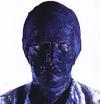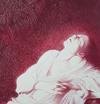Texts and Essays
REUTERS City , International / Art – November 30, 1999
One Man Show, Robert Sandelson Gallery, 2000
THE SHOCK OF THE REAL
A year or so back, an exhibition called Sensations caused a few upsets, first in London and then in New York. Central to the reaction was a large-scale portrait of a child-killer assembled from, if I remember correctly, the palm prints of children. So far, so bland. The shock element in art has been much talked about in the last five years but art that actually shocks has been thin on the ground during the same period.
Step forward then, Gottfried Helnwein.
The images on display at the Robert Sandelson Gallery (5a Cork Street, London W1) are eye-poppingly horrific. Several of Helnwein's big canvases depict officers in Nazi uniforms. On one scene, confident, well-groomed men gaze serenely and approvingly at what appears to be a naked infant Hitler, balanced on his mother's knee. In another, facially scarred war veterans are grouped round the limp figure of a child lying on a table with her legs dangling down lifelessly from the knees.
There's more. Of the remaining images, the majority depicts the remains of pickled foetuses from the eighteenth and nineteenth centuries, stored in Viennese museums. At about ten times life size (or, more accurately, death size) and rendered in a greenly yellow glow, these looks disturbingly alien. Their unstressed poses and closed eyelids suggest sleep rather than death.
Helnwein's precise photo-realism presents all these images with a bland unemotional detachment, and the evidence is much more compelling as a result. Skin, lips, eyes and hair are painted with dispassionate care in acrylic over digital prints of the original photographs. The wrinkled skin of a dead foetus seems somehow no less healthy than the smooth complexion of a contemporary young woman in a large portrait nearby. On the surface, all these images seem to be quite sanitary, yet their subject matter says otherwise.
There are no subjective brushstrokes in evidence, no smears, no mess, no distortion, no anger. And so the images speak loudly, clearly and shockingly.
But aren't Nazis and dead babies easy targets? If these pictures had been made in Britain, for example, that would be a relevant argument. But at the turn of the century, Austria remains tainted by its past in a way that Germany hasn't. Not being held responsible for either war or atrocities, the country failed to examine itself critically enough in the aftermath (as many Austrians have observed). Shameful incidents were quietly forgotten.
A doctor responsible for wartime experiments on children in Vienna was given an important government post as late as 1979. Helnwein's images were instrumented in having him removed and facing the law.
By and large, if art is going to shock, it better have something shocking to say, and it's clear that Helnwein has found that. If, on the other hand, you allow tabloid editors and publicity-hungry politicians to set the agenda on what's shocking, your art (and the comment that surrounds it) will almost certainly confine itself to the mundane and facile.


